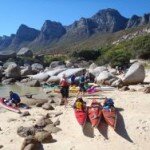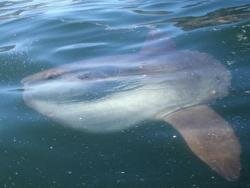Although False Bay is our `home water’ we have kayaked large stretches of the Greater Cape Town seaboard. It is not as daring as kayaking around Madagascar etc, but kayaking the Cape is awesome and as accessible as the local beach. We are spoilt for choice with everything from mellow meanders to adrenalin fueled action interspersed with wildlife encounters to remind us that we are the visitors.
We have enjoyed a number of Cape Classics – have had incredible experiences with whales, are often escorted by seals and periodically see sunfish and otter. Sharks you ask!!! Sorry, not on my eye-spy list. Once I saw a fin, or was it a piece of kelp?
Kayaking the Cape has taken us across False Bay from Millers Point to Rooiels, around Cape Point from Simon’s Town to Kommetjie, even around Robben Island and recently from Hout Bay to Three Anchor Bay, Cape Town.
 Hout Bay to Cape Town
Hout Bay to Cape Town
Sunday 1 May was perfect for paddling. We set off from Hout Bay beach into a tiny swell and a glassy, wind free sea. The famous Dungeons break was missing – a good sign! The sun was already warming sleepy shapes on Seal Island as we paddled through the channel. The more energetic individuals were in the water playing tag beneath our kayaks, silver bubbles tracking their passing. Suddenly we were included in the game and the race was on but easily won by a posse of seals catching up and then porpoising past us. We paddled on into the bay where the Maori was wrecked in the early 1900s. The steep cliffs of Kabonkelberg, that had thwarted attempts to rescue the sailors, cast dark shadows of indifference on what is now a popular wreck dive.
Around the corner a combination of prevailing swell, shallow reef and rebound from the rocky shore creates a notoriously bumpy stretch. It also marks the place where a crane barge grounded after its tow broke. The huge angular shape spectacular against the rounded granite is slowly being worn down by salt and surf.
We continued to thread our way between or around off-shore reefs and their attendant breakers depending on how threatening each appeared. At Llandudno a thundering shore break negated any thoughts of us beaching, although apparently the south eastern corner is a safe option – in an emergency. 
We entered Oudekraal Cove so well guarded by an outer band of reef that it is almost secret from the sea. Oudekraal was a revelation, a Boulders-of-the- Atlantic although the clear water and sandy seabed exposed shoals of skittish mullet rather than penguins. Oudekraal was a welcome lunch break after two and a half hours of sitting in a kayak. It may be a problem landing here in the height of the season when this beautiful but small beach is likely to be too crowded to accept a collection of kayaks.
to accept a collection of kayaks.
Refreshed and with a new layer of sunscreen, we set off for Three Anchor Bay. The party split with some threading their way close to the coast and others taking a more direct line toward Bakoven. The seaward contingent were rewarded with a close encounter with a Mola Mola Sunfish. Their fright reflex triggered by a prominent fin at close quarters was quickly replaced with the realization that it was not-a-shark, but a privileged encounter with an enigmatic pelagic visitor. I like to think of it as a lucky charm.
Kayaking close to the coast from picturesque Bakoven (a safe entry and exit to remember) to Clifton set against the dramatic Apostles of Table Mountain is simply special. Caution prevailed as we threaded our way between great granite reefs and frothing breakers which added an element of risk and adventure. In rougher conditions this would not be advisable.
We gave Clifton Beach a miss having  beached in the corner of 4th Beach on previous occasions. It had been a long day and like horses turned for home, we were starting to focus on the rewards at the end. In keeping with its exotic status, Clifton bay was host to a collection of launches and yachts each one a platform of sheer luxury. A comparison between our craft and these tweaked a brief discussion as we paddled past, caked in salt and starting to feel the distance in our shoulders. The consensus was that we were richer in terms of a sea experience – but it was admittedly a one sided discussion.
beached in the corner of 4th Beach on previous occasions. It had been a long day and like horses turned for home, we were starting to focus on the rewards at the end. In keeping with its exotic status, Clifton bay was host to a collection of launches and yachts each one a platform of sheer luxury. A comparison between our craft and these tweaked a brief discussion as we paddled past, caked in salt and starting to feel the distance in our shoulders. The consensus was that we were richer in terms of a sea experience – but it was admittedly a one sided discussion.
Lion’s Head looks at its most impressive seaward of Sea Point. From our vantage, it dwarfs the frenetic fringe of human development. A fringe that needs the protection of an extensive seawall – a wall that both protects and alienates the land from the sea. Three Anchor Bay slipway provides a safe gap in the wall for small craft and it is here that we ended our tour. Thank-you to Arthur and Tracy of Kaskasi for guiding us along this dramatically beautiful section of the Cape Town coast and for the cold beer. We will be back.
For more Kayaking the Cape stories read:
A Kayaker’s story about rounding Cape Point, South Africa https://scenicsouth.co.za//2010/02/point-taken-–-a-kayakers-perspective/
Watched by Whales off Simon’s Town – a story of paddlers being herded by Brydes Whales https://scenicsouth.co.za//2010/03/watched-by-whales-off-simon%e2%80%99s-town/
Click here for a and for a
Note to readers who may be inspired to paddle along our coastline. Some of these kayak trips are right up there with the most exciting hikes, paraglide flights, or dive sites. Like all outdoor adventures there are risks involved. Make sure you and your craft are genuinely seaworthy. This includes being fit and able to get yourself back into your boat if you fall out. Paddle with a pal. Ask experienced locals about the conditions and what to expect of the route. Two kayaking / paddling centers in Cape Town offer guided tours. Paddlers Kayak Shop in Simon’s Town (False Bay) ph , http://www.kayakcapetown.co.za and Kaskasi Kayaks at Three Anchor Bay (Atlantic Seaboard) ph or www.kaskasi.co.za
Photos by Silke Carstensen & Kaskasi.
KimK

2 Comment
Peninsula Paddlers set off from Sandvlei 3 june 2012 | The Scenic South, June 4, 2012 at 11:49 am
[...] Interested in reading about Cape Kayaking Classics along our coast go to: https://scenicsouth.co.za//2011/05/kayaking-the-cape-%e2%80%93-hout-bay-to-cape-town/ [...]
ReplySurfskiing in the Scenic South – the Miller’s Run to Fish Hoek attracts international paddlers | The Scenic South, March 14, 2012 at 2:27 pm
[...] https://scenicsouth.co.za//2011/05/kayaking-the-cape-%e2%80%93-hout-bay-to-cape-town/ [...]
Reply